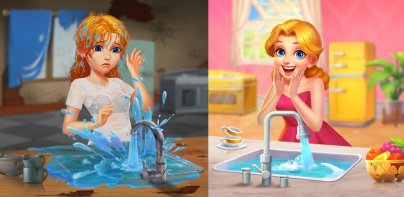


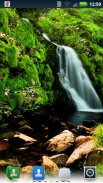


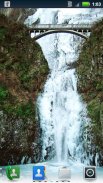
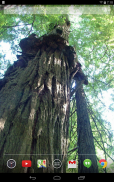
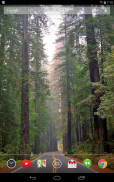
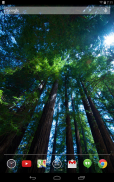
Scenic Waterfall Wallpaper

Perihal Scenic Waterfall Wallpaper
Waterfalls are commonly formed when a river is young. At these times the channel is often narrow and deep. When the river courses over resistant bedrock, erosion happens slowly, while downstream the erosion occurs more rapidly. As the watercourse increases its velocity at the edge of the waterfall, it plucks material from the riverbed. Whirlpools created in the turbulence as well as sand and stones carried by the watercourse increase the erosion capacity. This causes the waterfall to carve deeper into the bed and to recede upstream. Often over time, the waterfall will recede back to form a canyon or gorge downstream as it recedes upstream, and it will carve deeper into the ridge above it. The rate of retreat for a waterfall can be as high as one and half meters per year.
Often, the rock stratum just below the more resistant shelf will be of a softer type, meaning that undercutting due to splashback will occur here to form a shallow cave-like formation known as a rock shelter under and behind the waterfall. Eventually, the outcropping, more resistant cap rock will collapse under pressure to add blocks of rock to the base of the waterfall. These blocks of rock are then broken down into smaller boulders by attrition as they collide with each other, and they also erode the base of the waterfall by abrasion, creating a deep plunge pool or gorge.
Baatara gorge waterfall near Tannourin, Lebanon
Streams become wider and shallower just above waterfalls due to flowing over the rock shelf, and there is usually a deep area just below the waterfall because of the kinetic energy of the water hitting the bottom. Waterfalls normally form in a rocky area due to erosion. After a long period of being fully formed, the water falling off the ledge will retreat, causing a horizontal pit parallel to the waterfall wall. Eventually, as the pit grows deeper, the waterfall collapses to be replaced by a steeply sloping stretch of river bed.[1] In addition to gradual processes such as erosion, earth movement caused by earthquakes or landslides or volcanoes can cause a differential in land heights which interfere with the natural course of a water flow, and result in waterfalls.
If you’re not sure what live wallpapers are, they're a type of application that works on a mobile device using the Android operating system like your device!. The application works as a wallpaper – providing the background image for the home screen—but also works as a conventional application since it can provide user-interaction with the touch screen allowing the image to change dynamically, for example and access other hardware and software features within the device accelerometer, GPS, network access, etc..
**Multiple backgrounds!** Switch up the background as often or as little as you like with user-configurable options.
**Power saving features!** This app uses much less power than typical live wallpapers. It will take a bit more power to operate than a normal wallpaper, but much, much less battery power than the average live wallpaper.
**Super easy to use!** Upon install the app will bring up the options menu and then immediately let you set the wallpaper. No hassle and easy to use!
**Translated to 35 languages!** Do you really, really want to learn Russian? We didn’t think so, but it’s available just in case, in any language your phone can display!
Please note that live wallpapers can’t be set automatically. We’ll bring you to the setup screen where you’ll select the live wallpaper. We’d love to do it automatically but Android doesn’t allow it. Maybe some day.
Select text from Wikipedia, which does not endorse this product. No waterfalls were splashed in the making of this app. Licensed under the creative commons (creativecommons.org/licenses/by/3.0/). Text at wikipedia.org/wiki/Live_Wallpaper and wikipedia.org/wiki/waterfall.
</div> <div jsname="WJz9Hc" style="display:none">Air terjun biasanya terbentuk apabila sungai yang masih muda. Pada waktu-waktu saluran sering sempit dan dalam. Apabila kursus sungai lebih batuan dasar tahan, hakisan yang berlaku secara perlahan-lahan, manakala hiliran hakisan berlaku dengan lebih cepat. Sebagai saluran air meningkatkan halajunya di tepi air terjun, ia plucks bahan dari dasar sungai. Whirpool diwujudkan dalam pergolakan serta pasir dan batu-batu yang dibawa oleh saluran air meningkatkan kapasiti hakisan. Ini menyebabkan air terjun untuk mengukir jauh ke dalam katil dan surut huluan. Selalunya masa ke masa, air terjun akan surut kembali untuk membentuk ngarai atau gaung hiliran kerana ia semakin hilang hulu, dan ia akan mengukir lebih mendalam ke dalam batas di atasnya. Kadar berundur untuk air terjun boleh setinggi satu setengah meter setahun.
Selalunya, strata batu di bawah rak lebih tahan akan jenis yang lebih lembut, yang bererti bahawa pemotongan kerana splashback akan berlaku di sini untuk membentuk pembentukan gua seperti cetek yang dikenali sebagai tempat perlindungan batu di bawah dan di belakang air terjun. Akhirnya, outcropping, lebih tahan cap batu akan runtuh di bawah tekanan untuk menambah blok batu ke pangkal air terjun. Blok-blok batu adalah kemudiannya terurai ke dalam batu yang lebih kecil oleh pergeseran kerana mereka berlanggar antara satu sama lain, dan mereka juga menghakis asas air terjun oleh lelasan, mewujudkan kolam terjun dalam atau gaung.
Baatara air terjun gaung berhampiran Tannourin, Lebanon
Sungai menjadi lebih luas dan cetek di atas air terjun kerana mengalir di atas rak bukit batu itu, terdapat biasanya kawasan dalam di bawah air terjun kerana tenaga kinetik air memukul bahagian bawah. Air terjun biasanya terbentuk di kawasan yang berbatu akibat hakisan. Selepas tempoh yang panjang yang terbentuk sepenuhnya, air terjatuh dari tebing itu akan berundur, menyebabkan lubang selari mendatar ke dinding air terjun. Akhirnya, sebagai pit tumbuh lebih dalam, air terjun runtuh untuk digantikan dengan hamparan curam landai dasar sungai. [1] Selain proses beransur-ansur seperti hakisan, pergerakan bumi yang disebabkan oleh gempa bumi atau tanah runtuh atau gunung berapi boleh menyebabkan perbezaan dalam tanah tahap yang mengganggu kursus semula jadi aliran air, dan hasilnya dalam air terjun.
Jika anda tidak pasti apa yang wallpapers hidup adalah, mereka yang jenis permohonan yang bekerja pada peranti mudah alih menggunakan sistem operasi Android seperti peranti anda!. Permohonan itu bekerja sebagai kertas dinding a - menyediakan imej latar belakang untuk rumah juga perkakasan dan perisian lain ciri-ciri skrin tetapi-kerja-kerja sebagai aplikasi konvensional kerana ia boleh menyediakan pengguna-interaksi dengan skrin sentuh yang membolehkan imej untuk mengubah dinamik, sebagai contoh dan akses dalam pecutan peranti, GPS, akses rangkaian, dan lain-lain.
** Latar belakang Pelbagai! ** Tukar sehingga latar belakang sekerap atau sesedikit yang anda suka dengan pilihan pengguna-dikonfigurasikan.
** Ciri penjimatan Kuasa! ** Aplikasi ini menggunakan kuasa yang lebih kurang daripada wallpapers hidup biasa. Ia akan mengambil masa yang lebih kuasa untuk beroperasi daripada kertas dinding biasa, tetapi lebih, kuasa bateri lebih kurang daripada kertas dinding hidup purata.
** Super mudah untuk digunakan! ** Setelah memasang aplikasi tersebut akan membawa menu pilihan dan kemudian segera membiarkan anda menetapkan kertas dinding. Tiada kerumitan dan mudah untuk digunakan!
** Diterjemahkan kepada 35 bahasa! ** Adakah anda benar-benar, benar-benar mahu belajar Rusia? Kami tidak fikir begitu, tetapi ia boleh didapati hanya dalam kes, di mana-mana bahasa telefon anda boleh memaparkan!
Sila ambil perhatian bahawa wallpapers secara langsung tidak boleh ditetapkan secara automatik. Kami akan membawa anda ke skrin persediaan di mana anda akan memilih kertas dinding hidup. Kita akan suka melakukannya secara automatik tetapi Android tidak membenarkan ia. Mungkin beberapa hari.
Pilih teks dari Wikipedia, yang tidak menyokong produk ini. Tiada air terjun telah disimbah dalam pembuatan aplikasi ini. Dilesenkan di bawah Creative Commons (creativecommons.org/licenses/by/3.0 /). Text di wikipedia.org / wiki / Live_Wallpaper dan wikipedia.org / wiki / air terjun.</div> <div class="show-more-end">











